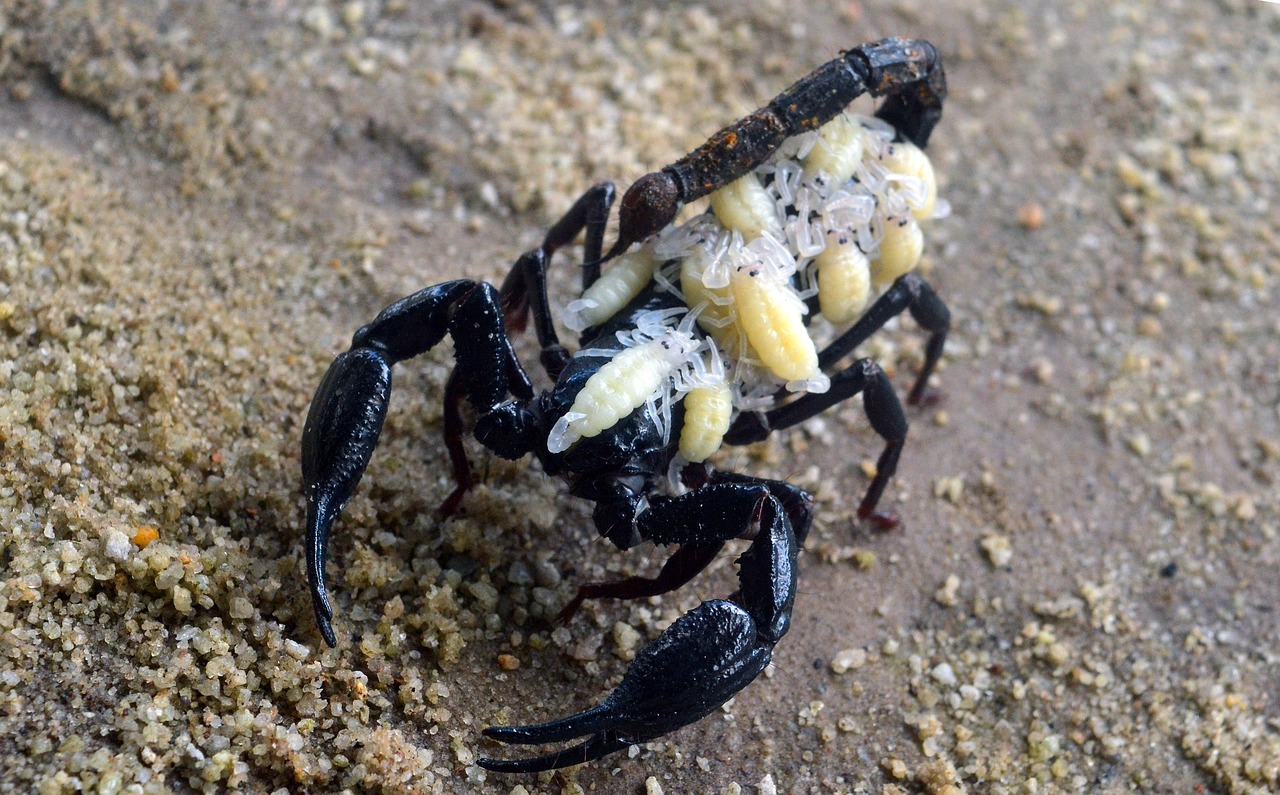In the harsh deserts of North Africa and the Middle East, where temperatures soar above 120°F and water is scarce, lives one of nature’s most feared creatures. The deathstalker scorpion doesn’t hunt with brute force or impressive size—it’s barely four inches long. Instead, this arachnid wields something far more sinister: a venom cocktail so potent that a single sting can kill a human within hours. Yet in a twist that would make any thriller writer jealous, this same deadly weapon might hold the key to saving countless lives.
Meet the Deathstalker: Nature’s Tiny Assassin

The deathstalker scorpion, scientifically known as Leiurus quinquestriatus, earned its ominous name through centuries of human encounters gone wrong. Unlike its bulkier cousins who rely on powerful claws, this pale yellow hunter is built for speed and stealth. Its slender pincers and lightning-fast tail movements make it one of the most agile predators in the arachnid world.
What makes this creature truly terrifying isn’t just its aggressive nature, but its incredible adaptability. Deathstalkers can survive without food for up to a year, slow their metabolism to nearly nothing, and withstand radiation levels that would kill most living things. They’re basically the cockroaches of the scorpion world, but with a much deadlier bite.
The Venom That Terrorizes and Transforms

When a deathstalker strikes, it injects a complex mixture of neurotoxins that attack the nervous system with surgical precision. The venom doesn’t just cause pain—it hijacks the victim’s neural pathways, causing uncontrollable muscle spasms, difficulty breathing, and ultimately heart failure. Children and elderly people are particularly vulnerable, with mortality rates reaching 75% in untreated cases.
But here’s where the story takes an unexpected turn. Scientists have discovered that this same venom contains compounds that can target cancer cells with remarkable accuracy. It’s like finding out that a serial killer has been secretly performing brain surgery on the side.
How Scientists Discovered the Hidden Treasure
The breakthrough came in the 1990s when researchers at the University of Alabama were studying how deathstalker venom affects brain tissue. They noticed something peculiar: certain components of the venom seemed to bind specifically to glioma cells—the aggressive brain cancer cells that form deadly tumors. This wasn’t just random chance; the venom was actively seeking out and attaching to cancer cells while leaving healthy tissue alone.
Dr. Harald Sontheimer, the lead researcher, described it as watching a guided missile find its target. The venom peptides were acting like molecular bloodhounds, sniffing out cancer cells in a crowd of healthy ones. This discovery launched a medical revolution that continues to this day.
Chlorotoxin: The Star Player in Cancer Treatment
The specific compound responsible for this miraculous targeting ability is called chlorotoxin, a 36-amino acid peptide that makes up just a tiny fraction of the deathstalker’s venom. When scientists isolated this compound, they found it could bind to chloride channels that are overexpressed in many types of cancer cells. Think of it as a key that only fits into cancer cell locks.
What makes chlorotoxin even more remarkable is its selectivity. Unlike chemotherapy drugs that attack both healthy and cancerous cells, chlorotoxin shows a preference for malignant tissue that’s almost supernatural. It’s as if nature designed the perfect cancer-seeking bullet and housed it in one of the world’s most dangerous creatures.
Brain Cancer: The First Battlefield
Glioblastoma multiforme, the most aggressive form of brain cancer, has long been considered a death sentence. Traditional treatments often fail because the blood-brain barrier prevents most drugs from reaching tumor cells. But chlorotoxin can cross this barrier like a VIP with backstage passes.
Clinical trials have shown that when chlorotoxin is attached to radioactive isotopes or fluorescent dyes, it can illuminate brain tumors during surgery, helping surgeons remove cancerous tissue with unprecedented precision. Patients who received this treatment showed significantly better outcomes than those who underwent conventional surgery alone.
Beyond the Brain: Expanding the Battlefield
While brain cancer was the first target, researchers quickly realized that chlorotoxin’s talents extended far beyond the skull. Laboratory studies have shown promising results against prostate cancer, breast cancer, and even certain types of leukemia. The compound seems to have an almost supernatural ability to recognize the molecular signatures of malignant cells.
In prostate cancer trials, chlorotoxin-based treatments have shown the ability to slow tumor growth and reduce metastasis—the spread of cancer to other parts of the body. For breast cancer patients, early research suggests the compound might help overcome drug resistance, one of the biggest challenges in oncology.
The Technology Behind the Magic

Modern biotechnology has transformed deathstalker venom from a crude killer into a precision medical instrument. Scientists now use synthetic biology to produce chlorotoxin in laboratory settings, eliminating the need to milk thousands of scorpions. Genetically modified bacteria can produce the compound in large quantities, making it feasible for widespread medical use.
Researchers have also developed sophisticated delivery systems that can carry chlorotoxin directly to tumor sites. These include nanoparticles, liposomes, and even engineered viruses that act as molecular delivery trucks. It’s like having a GPS system for cancer treatment.
Current Clinical Trials and Patient Stories

Multiple clinical trials are currently underway around the world, testing various chlorotoxin-based treatments. The results have been encouraging enough that the FDA has granted fast-track status to several chlorotoxin-derived therapies. Patients who had exhausted conventional treatment options are now seeing their tumors shrink or disappear entirely.
One particularly striking case involved a 45-year-old teacher with an inoperable brain tumor. After receiving chlorotoxin-guided surgery, surgeons were able to remove 95% of the tumor—something that would have been impossible with traditional methods. She’s now cancer-free and back in the classroom, teaching her students about the wonders of medical science.
The Scorpion Farm Revolution

The growing demand for deathstalker venom has spawned an entirely new industry: scorpion farming. Facilities in Israel, Jordan, and other Middle Eastern countries now house thousands of deathstalkers in climate-controlled environments. These aren’t your typical farms—they’re high-tech operations that require specialized equipment and highly trained personnel.
Milking a deathstalker is an art form that requires nerves of steel and precise timing. Workers use electrical stimulation to encourage venom release, collecting tiny drops that are worth more than gold by weight. A single gram of purified deathstalker venom can sell for over $10,000 on the pharmaceutical market.
Other Medical Applications Under Investigation

Cancer treatment is just the beginning of chlorotoxin’s medical potential. Researchers are exploring its use in treating autoimmune diseases, where the compound’s ability to target specific cell types could help calm overactive immune systems. Early studies suggest it might be effective against multiple sclerosis and rheumatoid arthritis.
The compound is also being investigated as a potential treatment for certain types of epilepsy. Its ability to modulate ion channels in brain cells could help prevent the electrical storms that trigger seizures. Some researchers even believe it might have applications in treating chronic pain conditions.
The Challenges of Weaponizing Venom

Despite its promise, turning deathstalker venom into medicine isn’t without challenges. The compound is notoriously unstable and breaks down quickly in the human body. Scientists are working on ways to modify its structure to make it more durable while preserving its cancer-targeting abilities.
There’s also the question of side effects. While chlorotoxin is much safer than the raw venom, it can still cause problems in some patients. Researchers are conducting extensive safety studies to understand the full range of potential complications and how to minimize them.
The Future of Scorpion-Based Medicine
The success of chlorotoxin has sparked interest in other scorpion venoms as potential medical goldmines. Scientists are now studying venoms from dozens of different species, looking for compounds that might treat everything from heart disease to Alzheimer’s. The Arizona bark scorpion, for instance, produces a venom that shows promise against certain types of lung cancer.
Artificial intelligence is accelerating this research by helping scientists predict which venom components might have therapeutic value. Machine learning algorithms can analyze the molecular structures of thousands of compounds in minutes, identifying potential drug candidates that might have taken years to discover through traditional methods.
Environmental Conservation and Medical Progress
The medical potential of deathstalker venom has created an unexpected ally in conservation efforts. Desert habitats that were once considered worthless are now recognized as pharmaceutical treasure troves. Countries like Jordan and Israel are investing in scorpion conservation programs, protecting the ecosystems that produce these valuable creatures.
This has created a fascinating economic incentive for environmental protection. Local communities that once viewed scorpions as nothing but pests are now seeing them as valuable resources worth protecting. It’s a perfect example of how medical research can create positive environmental outcomes.
The Ethical Considerations

The commercialization of deathstalker venom raises important ethical questions about who should benefit from these natural resources. Many of the countries where these scorpions live are developing nations with limited access to advanced medical care. There’s ongoing debate about how to ensure that local communities share in the profits from their natural heritage.
Some researchers argue for a model similar to the one used for certain plant-based medicines, where a percentage of profits goes back to the communities and countries where the source organisms are found. This could help fund local healthcare infrastructure and conservation efforts while ensuring that the benefits of medical breakthroughs are shared more equitably.
The deathstalker scorpion represents one of nature’s most perfect paradoxes—a creature whose deadly venom may ultimately save more lives than it takes. As clinical trials continue and new applications are discovered, we’re witnessing the transformation of one of our most feared predators into one of our most valuable medical allies. The journey from desert terror to cancer cure reminds us that sometimes the most powerful solutions come from the most unexpected places.
What other secrets might be hiding in nature’s pharmacy, waiting for the right scientist to unlock their potential?

